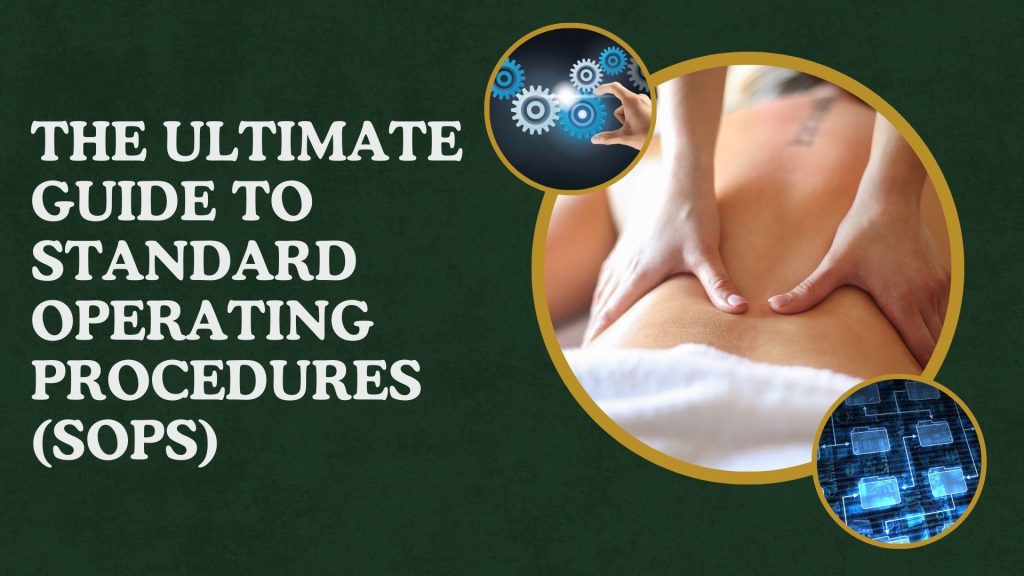Running a massage therapy business requires more than just a skilled touch—it demands consistency, organization, and efficiency. That’s where massage SOPs (Standard Operating Procedures) come into play. SOPs are detailed, step-by-step instructions designed to help you streamline operations, ensure consistent client experiences, and foster business growth.
In this in-depth guide we will explore what massage SOPs are, why they’re essential, how to create them, and key areas where you should implement SOPs in your massage business. Whether you’re a solo practitioner or running a multi-location spa, establishing clear SOPs can help you scale, reduce stress, and ensure long-term success.
What Are Massage SOPs and Why Do They Matter?
Standard Operating Procedures (SOPs) are detailed, written instructions designed to achieve uniformity in the performance of specific functions. In a massage therapy context, SOPs outline the step-by-step processes for tasks ranging from client intake to sanitation practices. For broader team alignment, also consider developing a comprehensive massage employee handbook alongside your SOPs to clearly communicate policies and expectations.
The goal of SOPs is to provide clear guidelines for employees (or yourself) to follow, ensuring tasks are performed consistently and efficiently, and are key a part of your overall massage business systems.
Why They Matter:
- Consistency: Ensures every client receives the same high-quality service.
- Efficiency: Streamlines operations, saving time and resources.
- Compliance: Helps meet industry regulations and standards.
- Training: Simplifies onboarding and training of new staff.
- Quality Control: Facilitates monitoring and improvement of services.
The Benefits of Implementing SOPs in Your Massage Practice
a. Enhances Client Satisfaction
Consistency in service delivery builds trust and enhances the client experience. When clients know what to expect, they’re more likely to return and refer others.
b. Improves Operational Efficiency
Standardizing procedures minimizes errors and reduces the time spent on tasks, allowing you to serve more clients effectively.
c. Facilitates Staff Training and Development
New hires can quickly get up to speed by following documented procedures, reducing training time and costs. Pairing SOPs with a structured onboarding process for massage employees ensures your team feels supported from day one.
d. Ensures Compliance and Safety
SOPs help you adhere to health and safety regulations, minimizing legal risks and ensuring a safe environment for both clients and staff.
Key Areas for SOP Development
To fully optimize your massage business, focus on developing SOPs in the following critical areas:
a. Client Intake and Consultation
- Appointment Scheduling: Procedures for booking appointments via phone, online, or in-person.
- Intake Forms: How to collect and store client information securely.
- Consultation Protocol: Guidelines for initial consultations, including questions to ask and information to provide.
b. Treatment Room Preparation
- Room Setup: Steps for preparing the massage table, lighting, and ambiance.
- Equipment Check: Ensuring all tools and equipment are in working order.
- Supplies Inventory: Maintaining adequate stock of oils, linens, and other essentials.
c. Massage Session Protocols
- Greeting the Client: How to welcome clients professionally.
- Session Flow: Detailed steps for conducting various types of massages.
- Client Communication: Guidelines for checking comfort levels and obtaining feedback during the session.
d. Sanitation and Hygiene Practices
- Handwashing Procedures: When and how to wash hands before and after sessions.
- Linen Handling: Proper methods for changing and laundering linens.
- Disinfection Protocols: Cleaning procedures for equipment and surfaces.
e. Client Follow-Up and Retention
- Post-Session Communication: Sending thank-you messages and requesting feedback.
- Rebooking Strategies: Encouraging clients to schedule their next appointment.
- Loyalty Programs: Implementing incentives for repeat clients.
f. Emergency Procedures
- Medical Emergencies: Steps to take if a client experiences a health issue during a session.
- Facility Emergencies: Protocols for fire, power outages, or other unexpected events.
- Reporting Incidents: How to document and report any incidents appropriately.
A Step-by-Step Guide to Creating Effective Massage SOPs
Step 1: Assess Your Current Processes
Begin by evaluating your existing procedures. Identify tasks that lack consistency or areas where mistakes frequently occur.
Step 2: Define Clear Objectives
What do you hope to achieve with each SOP? Whether it’s improving client satisfaction or ensuring compliance, clear goals will guide the development process.
Step 3: Involve Your Team
Your staff can provide valuable insights into daily operations. Collaborate with them to identify pain points and solutions.
Step 4: Document Procedures in Detail
Write step-by-step instructions for each task. Be precise and use clear, concise language to avoid misunderstandings.
Example for Handwashing SOP:
- Wet hands with clean, running water.
- Apply soap and lather thoroughly.
- Scrub hands for at least 20 seconds.
- Rinse under clean, running water.
- Dry hands using a clean towel or air dryer.
Step 5: Use Visual Aids and Checklists
Incorporate flowcharts, diagrams, or checklists to make the SOPs more user-friendly.
Step 6: Review and Revise Regularly
Schedule periodic reviews to ensure the SOPs remain relevant and effective. Update them to reflect any changes in regulations or business practices.
Bonus Tips for Successful SOP Implementation
- Training Sessions: Conduct workshops or meetings to introduce the SOPs to your team.
- Accessible Documentation: Make sure the SOPs are easily accessible, either in print or digitally.
- Feedback Mechanism: Encourage staff to provide feedback for continuous improvement.
- Leadership Support: Lead by example and ensure management consistently follows the SOPs.
Maintaining and Updating Your SOPs
Regular maintenance of your SOPs is crucial for sustained success.
- Annual Reviews: At minimum, review all SOPs once a year.
- Regulatory Changes: Update SOPs immediately to comply with new laws or industry standards.
- Technological Advances: Incorporate new technologies that can improve efficiency or client experience.
- Staff Changes: Modify SOPs to reflect changes in team structure or roles.
Conclusion
Implementing comprehensive massage SOPs is not just about ticking boxes; it’s about elevating your business to new heights of professionalism and efficiency. By standardizing your operations and fleshing out your Massage operations manual you ensure that every client interaction is a positive one, fostering loyalty and encouraging word-of-mouth referrals.
Remember, the effectiveness of your SOPs depends on their relevance and the commitment of your team to follow them. Invest the time to create, implement, and regularly update your SOPs, and you’ll set your massage practice on a path to sustained success.
Key Takeaways:
- Consistency is Key: SOPs ensure every client receives the same high-quality service.
- Staff Empowerment: Clear procedures enable your team to perform their duties confidently and efficiently.
- Continuous Improvement: Regularly updating your SOPs keeps your business aligned with industry best practices.
- Competitive Advantage: A well-organized operation can set you apart in a crowded market.
Optimize Your Massage Business Today
Start developing your massage SOPs now to streamline your operations, enhance client satisfaction, and drive business growth. With this guide as your roadmap, you’re well on your way to mastering the art of operational excellence in the massage therapy industry. For more resources and expert guidance, visit Scaling Wellness.






